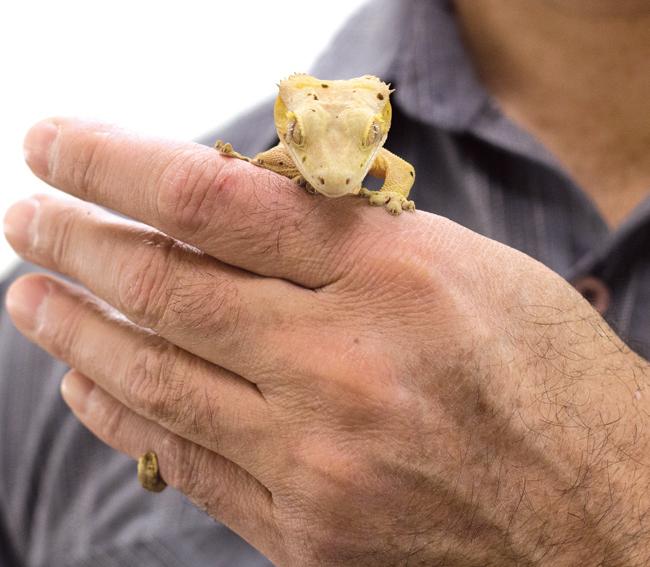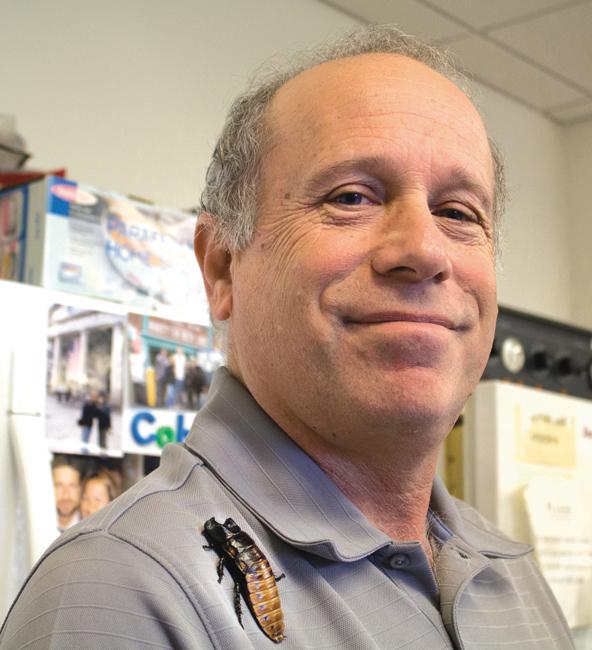
Photo Credit Trevor Stamp / Daily Sundial
Herpetologist, entomologist and ichthyologist are career fields that are uncommon to most of us. One may ponder who these individuals are and what they may do, but luckily for us, we have them right here on CSUN’s campus.
While most people spend years trying to figure out their career paths, at a young age Dr. Robert Espinoza, professor of biology, knew exactly what he wanted to do for the rest of his life.
“By the time I was 8 or 9, I knew exactly what I wanted to do,” Espinoza said.
His interest in animals sparked when he started collecting creatures he interacted with in his backyard. Espinoza said he has the best job in the world, being a herpetologist, one who studies amphibians and reptiles.
Eventually, he had collected an array of pets from bugs and lizards, toads and turtles, chipmunks and at one point, an alligator.
Though interacting with animals was a hobby for Espinoza, his unique interest for reptiles and amphibians helped him financially through college.
“In junior high, I wanted an iguana, so I built a cage in my woodshop class,” Espinoza said. “By the time I finished the cage, I didn’t want an iguana anymore, but turned my interest to boa constrictors. I got my first boa in high school and by early college I was breeding them, and selling the babies actually helped pay my way through college.”
Espinoza was kicked out of his apartment during college because he was caught breeding and selling snakes from a studio that did not allow pets.
As a herpetologist, Espinoza not only gets to study the physiology of amphibians and reptiles, but he often researches them in their natural habitats, which gives him the opportunity to travel.
“I get to travel to beautiful places all over the world and study the animals I love,” Espinoza said. “In many of these places I’ve developed close friendships with my fellow herpetologists. I would never have had the opportunity to go to these places or get to know these people if it were not for herpetology, so that alone is great.”
Espinoza also shared an interesting story about photographing snakes at a museum in Argentina. While transferring a venomous snake by elevator to the garden floor, it suddenly jumped out of its bucket.
Having only a stick, a bucket and a camera, Espinoza managed to prevent the snake from escaping down the elevator shaft and safely got it back into the bucket. Though Espinoza walked away unharmed, he admits he was shaken from the experience.
Another interesting expertise among CSUN professors is ichthyology, a branch of zoology devoted to studying fish.
“I just love fish,” said Dr. Larry Allen, marine biology professor and ichthyologist. “I just like and I want to know everything I can about them.”
Allen’s zeal for water and marine life began when he was 4 years old. The first time he went fishing with his father and grandfather, he knew he wanted to spend the rest of his life studying everything there is to know about fish.
“Being on the ocean since the 1950s, I always knew I was destined to be a fish biologist,” Allen said.
For Allen, it was never about the money or swimming with dolphins that intrigued his curiosity about the marine life, rather it was his passion for the unseen world.
“To be a marine biologist, one must have sensational curiosity,” Allen said.
One of his favorite species is the 7-foot long, 150-pound giant sea bass, which became extinct in the 1930s, but has surprisingly resurfaced. Allen also admires the trout, a fish he’s been studying for years. He is currently studying a specific species of trout from New Zealand with one of his graduate students.
Though some of his experiences don’t come nearly as close to the danger Espinoza faced, Allen encountered his fair share of crises in the water. In 1998, he experienced the El Niño in Brazil while doing research, an event he described as unforgettable.
While embarking on his underwater excursions, Allen experienced quite a bit of nitrogen narcosis, also known as “narced” in divers’ language. Nitrogen narcosis is an altered state of mind caused by breathing nitrogen at high partial pressure (pressure exerted by an individual gas in a mixture of gases), at about 140 feet under water.
Regardless of his encounters with peril, Allen remains gutsy and ready to take on another adventure in the ocean satisfying his curiosity with the world he’s gained an abundance of passion for.
While there are many who are either disgusted, afraid or creeped out by crawling critters, for CSUN professor Randy Cohen, a biologist and entomologist, this is not the case. He finds them so intriguing that the focus of his undergraduate studies were spiders and fungi.

Photo Credit Trevor Stamp / Daily Sundial
“I have always been intellectually curious of how things work,” Cohen said. “And unlike many of my entomologist colleagues, I didn’t have an insect collection as a kid. I was always interested in looking and observing, but my interest in insects didn’t start until graduate school, specifically.”
Cohen has never traveled to research insects. Instead, he spends most of his time doing research on insects in the laboratory.
“Pretty much every day of the year there are insects around,” Cohen said. “So there are always insects around, especially during the spring. Just pick up a rock and you will find them.”
Cohen’s interest about cockroaches was captivated by their uniqueness as a model organism. He explained that cockroaches and humans are model organisms and the neurotransmitter in both organisms are analogous.
“For example, the neurotransmitter serotonin seems to go up when cockroaches eat a very high carbohydrate meal and that seems to trigger a change in the behavior of the animal and they start in more protein meals,” Cohen said. “Many of the neurotransmitters that we’re studying in insects also works in humans like serotonin.”
Cohen further explained that when humans eat a high carbohydrate meal, the level of serotonin in certain regions of the brain increase and that triggers them to stop eating or think about another meal.
Cohen is currently developing a colony of tiger beetles to see how they mature and reproduce, while also researching how a predator works and how they select their prey.
If it is one thing these professors have in common, it is curiosity. They have a growing interest and passion for what they do and while others might find their interest unexpected, they spend their days doing what they love.